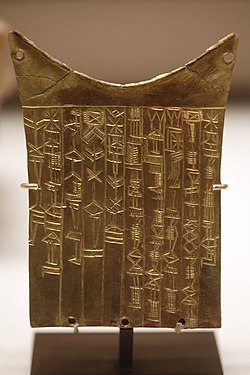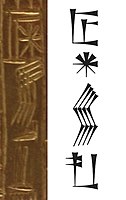Bara-irnun
| Bara-irnun 𒁈𒅕𒉣 | |
|---|---|
| Queen of Umma | |
 Votive plate of Queen Bara-Irnun of Umma, "wife of Gishakidu, king of Umma, daughter of Ur-Lumma, king of Umma, grand-daughter of Enakalle, king of Umma, daughter-in-law of Il, king of Umma", to God Shara, in gratitude for sparing her life. Louvre Museum. | |
| Reign | c. 2500 BC – 2400 BC |
| Dynasty | 1st Dynasty of Umma |
Bara-irnun (𒁈𒅕𒉣 bara-ir-nun) was queen of the Sumerian city-state of Umma and wife of king Gishakidu, circa 2400 BCE. She is particularly known from a gold votive plate, in which she describes her genealogy in great detail. The inscription on the plate reads:
For (the god) Shara, lord of the E-mah: when Bara-irnun - wife of Gishakidu, king of Umma, daughter of Ur-Lumma, king of Umma, grand-daughter of Enakalle, king of Umma, daughter-in-law of Il, king of Umma - had made Shara resplendent and had built him a holy throne, for her life, to Shara, in the E-Mah, she offered (this ornament)."
— Inscription of Bara-Irnum
The original royal line of Umma consisted in the filiation of Enakalle (possibly son of Ush) and his own son Ur-Lumma. When Ur-Lumma died, presumably without a son but certainly with a daughter named Bara-irnum, the throne was handed over to Il, son of Eanandu (who had no regnal title) and grandson (or nephew) of Enakalle. King Il was then succeeded by his own son Gishakidu. Bara-irnum married her cousin Gishakidu, thus re-uniting both strands of the royal family by a marital alliance.
The plaque is the first known mention of Shara, tutelary god of Umma.




